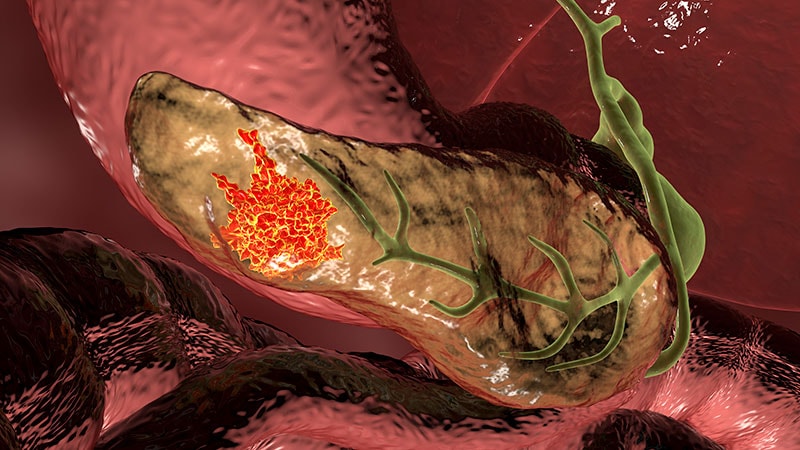betekintés - Computational Biology - # Targeting Tumor Extracellular Matrix to Reverse Chemoresistance in Pancreatic Cancer
Manipulating Tumor Microenvironment to Overcome Chemoresistance in Pancreatic Cancer
Alapfogalmak
Manipulating the stiffness and biochemical properties of the tumor microenvironment can reverse chemoresistance in pancreatic cancer.
Kivonat
The article discusses a new research study that explores the role of the tumor microenvironment in influencing the progression and drug response of pancreatic cancer. The key insights are:
- Pancreatic cancer is characterized by a dense fibrous tissue called the extracellular matrix that can collapse blood vessels and prevent drugs from reaching the tumor.
- The researchers engineered synthetic 3D pancreas tissue with varying degrees of stiffness and biochemical properties, and found that cancer cells growing in a stiffer matrix were more resistant to chemotherapy.
- This resistance was linked to the high levels of the tissue-strengthening protein hyaluronic acid in the stiff matrix, which signaled the cancer cells to develop pumps that expelled the drugs.
- When the cancer cells were moved to a softer matrix or a stiff matrix with the hyaluronic acid receptor blocked, the chemotherapy drugs became effective again.
- These findings suggest that disrupting the stiffness signaling through the CD44 receptor could make pancreatic cancer treatable again with standard chemotherapy.
- The study highlights the importance of the tumor microenvironment in dictating cancer progression and drug response, and demonstrates the potential of "mechanotherapeutics" - targeting the surrounding tissue - as a novel approach to fighting chemoresistance.
Összefoglaló testreszabása
Átírás mesterséges intelligenciával
Hivatkozások generálása
Forrás fordítása
Egy másik nyelvre
Gondolattérkép létrehozása
a forrásanyagból
Forrás megtekintése
www.medscape.com
'Chemoresistance Can Be Reversed': Toughest Cancers Targeted
Statisztikák
Each year, about 66,000 people are diagnosed with pancreatic cancer, and 52,000 die from it.
Pancreatic cancer has a 5-year survival rate of around 7%, which has not improved much since 1996.
Idézetek
"Our study shows the importance of the tumor microenvironment and its properties in dictating how cancer progresses and responds to drug treatment."
"This suggests that if we can disrupt the stiffness signaling that's happening through the CD44 receptor, we could make patients' pancreatic cancer treatable again by normal chemotherapy."
Főbb Kivonatok
by Lisa Marshal... : www.medscape.com 07-18-2024
https://www.medscape.com/viewarticle/chemoresistance-can-be-reversed-toughest-cancers-targeted-2024a1000d7s
Mélyebb kérdések
What other signaling pathways or molecular targets could be explored to manipulate the tumor microenvironment and overcome chemoresistance in pancreatic cancer?
In addition to targeting the hyaluronic acid receptor CD44, which was highlighted in the study, other signaling pathways and molecular targets could be explored to manipulate the tumor microenvironment in pancreatic cancer. One potential target is the transforming growth factor-beta (TGF-β) pathway, which plays a crucial role in promoting fibrosis and creating a stiff extracellular matrix. Inhibiting TGF-β signaling could help reduce the density of the matrix, making it easier for chemotherapy drugs to penetrate the tumor. Additionally, targeting proteins involved in angiogenesis, such as vascular endothelial growth factor (VEGF), could improve blood vessel function and drug delivery to the tumor site. Exploring the role of immune cells in the tumor microenvironment and modulating their activity through immunotherapy could also enhance the response to chemotherapy in pancreatic cancer.
How can the findings from this study on pancreatic cancer be applied to other types of solid tumors with dense extracellular matrices?
The findings from this study on pancreatic cancer can be applied to other types of solid tumors with dense extracellular matrices by understanding the common mechanisms of chemoresistance and tissue stiffness across different cancer types. For instance, tumors like breast cancer, ovarian cancer, and lung cancer also exhibit dense fibrous tissue that hinders drug penetration. By studying how altering the stiffness of the microenvironment affects drug response in pancreatic cancer, researchers can apply similar strategies to these other tumor types. Techniques such as engineering synthetic tissues with varying stiffness levels and testing drug efficacy in these models can be adapted to study chemoresistance in different solid tumors. Moreover, targeting specific proteins or pathways involved in matrix remodeling and drug efflux, as identified in the pancreatic cancer study, may also be relevant for overcoming chemoresistance in other cancers with similar microenvironment characteristics.
What are the potential challenges and limitations in translating this approach of targeting the tumor microenvironment from the lab to the clinic?
Translating the approach of targeting the tumor microenvironment from the lab to the clinic faces several challenges and limitations. One major challenge is the complexity of the tumor microenvironment, which involves multiple cell types, signaling pathways, and interactions that may vary between patients and cancer types. Developing targeted therapies that effectively modulate the microenvironment without causing off-target effects or systemic toxicity is a significant hurdle. Additionally, the need for personalized treatment strategies based on individual tumor characteristics adds another layer of complexity to clinical implementation. Another limitation is the potential for resistance to therapies that target the microenvironment, as cancer cells can adapt and find alternative survival mechanisms. Moreover, the delivery of localized treatments to specific regions of the tumor microenvironment in patients may be technically challenging and require innovative drug delivery systems. Regulatory approval and cost-effectiveness of novel therapies targeting the microenvironment also pose barriers to clinical translation. Overall, while targeting the tumor microenvironment shows promise in overcoming chemoresistance, addressing these challenges is essential for successful clinical application.
0
